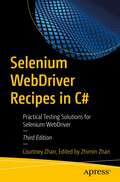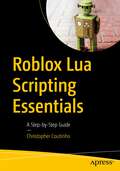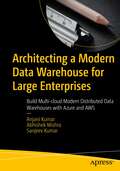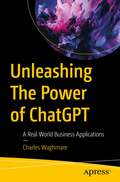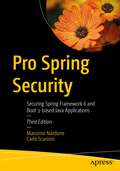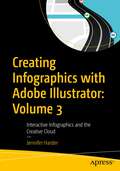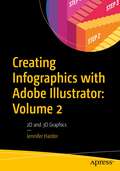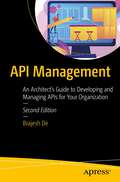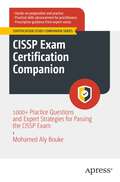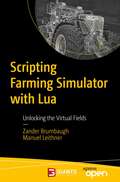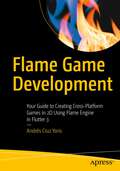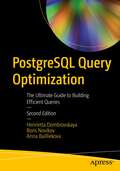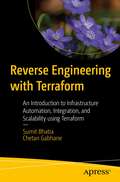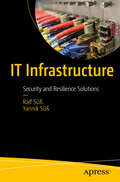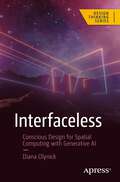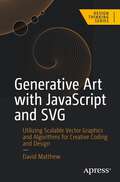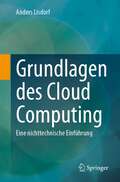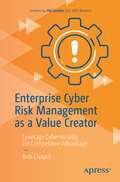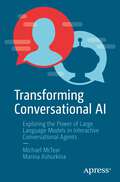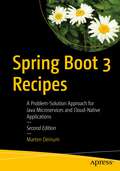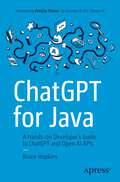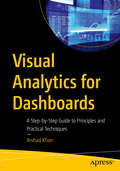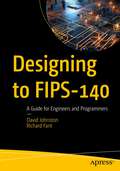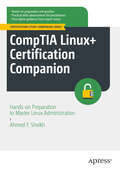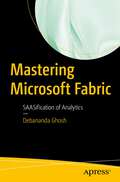- Table View
- List View
Selenium WebDriver Recipes in C#: Practical Testing Solutions for Selenium WebDriver
by Courtney ZhanSolve your Selenium WebDriver problems with this quick guide to automated testing of web applications with Selenium WebDriver in C#. This third edition contains hundreds of solutions to real-world problems, with clear explanations and ready-to-run Selenium test scripts that you can use in your own projects. Updated to Selenium version 4, this revision includes Visual Studio Code set up, additional recipes, and new chapters on Selenium DevTools and continuous testing. You'll see how to use Selenium WebDriver for select lists, navigation, assertions, frames, file upload and pop-up dialogs. You'll also learn how to locate web elements and test functions for hyperlinks, buttons, TextFields and TextAreas, radio buttons, CheckBoxes, and more. What You'll Learn Debug test scripts and test data Work with Selenium Remote Control Server Manage and deal with browser profiles and capabilities Monitor tests for advanced user interactions and experiences (UX) Who This Book Is For Experienced .NET and C# Windows application programmers/developers.
Roblox Lua Scripting Essentials: A Step-by-Step Guide
by Christopher CoutinhoEmbark on a transformative journey through the exciting world of Roblox Lua scripting with this comprehensive hands-on guide. Tailored to game developers, both seasoned and new, this book serves as your roadmap to mastering the art and science of Lua scripting within the dynamic Roblox Studio environment.You'll explore a wide spectrum of foundational concepts, including variables, functions, loops, tables, arrays, and more. Delve into advanced topics like raycasting, object-oriented programming with humanoids, and intricate leaderboard systems. Each chapter is crafted with real-world examples and step-by-step tutorials, empowering you to create engaging and interactive gameplay experiences.You'll gain profound insights into modularization, efficient coding practices, and techniques to optimize your scripts, paving the way to elevate your game development to an entirely new plane of creativity and complexity. You'll also discover sophisticated scripting concepts, such as custom events, and client-server communication. Invest in your future as a Roblox developer today, and let this book be your guide to crafting extraordinary gaming experiences. Roblox Lua Scripting Essentials provides the insight, tools, and guidance needed to shape your unique path in this thrilling domain of game development. What You'll Learn Wield variables, functions, loops, conditionals, arrays, and more to create dynamic gameplay elementsExplore the principles of object-oriented programming, and modularization techniques to develop clean, efficient, and organized codeUnderstand the complex client-server relationships, custom events, and multiplayer functionalities that bring games to lifeDiscover the power of modular coding, enabling you to create more organized and maintainable code basesLay down a robust foundation in Lua scripting for Roblox Who This Book Is For This book is meticulously crafted to serve a diverse array of readers, ranging from complete beginners to intermediate developers.
Architecting a Modern Data Warehouse for Large Enterprises: Build Multi-cloud Modern Distributed Data Warehouses with Azure and AWS
by Anjani Kumar Abhishek Mishra Sanjeev KumarDesign and architect new generation cloud-based data warehouses using Azure and AWS. This book provides an in-depth understanding of how to build modern cloud-native data warehouses, as well as their history and evolution. The book starts by covering foundational data warehouse concepts, and introduces modern features such as distributed processing, big data storage, data streaming, and processing data on the cloud. You will gain an understanding of the synergy, relevance, and usage data warehousing standard practices in the modern world of distributed data processing. The authors walk you through the essential concepts of Data Mesh, Data Lake, Lakehouse, and Delta Lake. And they demonstrate the services and offerings available on Azure and AWS that deal with data orchestration, data democratization, data governance, data security, and business intelligence. After completing this book, you will be ready to design and architect enterprise-grade, cloud-based modern data warehouses using industry best practices and guidelines. What You Will Learn Understand the core concepts underlying modern data warehousesDesign and build cloud-native data warehousesGain a practical approach to architecting and building data warehouses on Azure and AWSImplement modern data warehousing components such as Data Mesh, Data Lake, Delta Lake, and LakehouseProcess data through pandas and evaluate your model’s performance using metrics such as F1-score, precision, and recallApply deep learning to supervised, semi-supervised, and unsupervised anomaly detection tasks for tabular datasets and time series applications Who This Book Is For Experienced developers, cloud architects, and technology enthusiasts looking to build cloud-based modern data warehouses using Azure and AWS
Unleashing The Power of ChatGPT: A Real World Business Applications
by Charles WaghmareExplore the role ChatGPT can play in business, including operations, marketing, sales, and delivery. This concise book illustrates how ChatGPT is changing the way individuals interact with machines and how you can take advantage of its capabilities for business. The book starts with an overview of ChatGPT and its impact in the realm of of conversational AI. You will then dive into the technical aspects of ChatGPT and gain an understanding of how machine learning algorithms and natural language processing work in the background. Various business applications of ChatGPT are then discussed, followed by how it can get integrated into your business operations. To wrap things up, you will gain insight into the data and privacy elements that need to be considered while using ChatGPT, and how to maintain its integrity. After completing this book, you will understand the ChatGPT framework and how to integrate it into your own ventures. What You Will Learn Understand the various technologies and techniques utilized in ChatGPTGain insight into the future of human-machine interactionAnalyze the advantages and disadvantages of ChatGPT for your industryExplore the ethical implications of using AI Who This Book Is For Tech enthusiasts who are passionate about artificial intelligence (AI), machine learning, and human-machine interaction.
Pro Spring Security: Securing Spring Framework 6 and Boot 3-based Java Applications
by Massimo Nardone Carlo ScarioniBuild and deploy secure Spring Framework and Spring Boot-based enterprise Java applications with the Spring Security Framework. This book explores a comprehensive set of functionalities to implement industry-standard authentication and authorization mechanisms for Java applications.Pro Spring Security, Third Edition has been updated to incorporate the changes in Spring Framework 6 and Spring Boot 3. It is an advanced tutorial and reference that guides you through the implementation of the security features for a Java web application by presenting consistent examples built from the ground up.This book also provides you with a broader look into Spring security by including up-to-date use cases such as building a security layer for RESTful web services and JSON Web Token applications.What You Will LearnExplore the scope of security and how to use the Spring Security FrameworkMaster Spring security architecture and design Secure the web tier in Spring Work with alternative authentication providersTake advantage of business objects and logic securityExtend Spring security with other frameworks and languagesSecure the service layerSecure the application with JSON Web TokenWho This Book Is ForExperienced Spring and Java developers with prior experience in building Spring Framework or Boot-based applications
Creating Infographics with Adobe Illustrator: Interactive Infographics and the Creative Cloud
by Jennifer HarderThis full-color book, the third of three volumes, focuses on Adobe Illustrator’s SVG interactivity tools. How can an infographic be made more interactive for an audience? What additional Illustrator tools and Adobe applications can be used to enhance your infographic layout? In this final volume of Creating Infographics with Adobe Illustrator, you will learn the answers to all these questions. Author Jennifer Harder will walk you through creating basic infographics in Illustrator using Illustrator tools for creating SVG files, known as Scalable Vector Graphics, for basic Interactivity on a web page. Then you will review layouts in other Adobe Applications in relation to their connectivity with Illustrator. Upon completing this volume, you will have a thorough understanding of how to design an infographic with basic interactivity for a web page, and how this can improve visualization and convey meaning to your audience. Moreover, you will be able to use this knowledge to create your own infographics using Illustrator’s wide array of tools. What You Will Learn Discover how to apply interactivity to an infographicGain insight into different infographic layouts and how to finalize your project with your clientExplore other Adobe Creative Cloud applications that may assist you in the future as you create your infographics Who This Book Is For Beginner-level designers and others who are interested in learning the process of creating infographics for their company, the classroom, for, an article in a magazine, or adding interactivity to webpage.
Creating Infographics with Adobe Illustrator: 2D and 3D Graphics
by Jennifer HarderThis full-color book will teach you how to use Adobe Illustrator's various tools to create infographics, as well as basic page layouts for them. It focuses on Illustrator’s powerful graphing tools and 2D and 3D effects. How can an infographic or graph be altered and adapted to appear more engaging and still display your data accurately? What additional effects can be used on your infographic to produce the results you envision? In this second volume of Creating Infographics with Adobe Illustrator, you will learn the answers to all these questions. Author Jennifer Harder will walk you through creating basic infographics in Illustrator using Illustrator tools such as Graphing Tools as well as how to create 2D effects and 3D shapes with their related materials, including Symbols. Upon completing this volume, you will have an appreciation for how easy it is to design an infographic or graph to display your data and discover how rudimentary shapes and colors can be altered using patterns, as well as 2D and 3D effects, to enhance readability while conveying meaning to your audience. You will be able to use this knowledge to create your own infographics using Illustrator’s wide array of tools. What You Will Learn Use Illustrator’s Graphing Tools to create and modify basic charts or graphsWork with popular 2D effects to enhance your design in IllustratorCreate 3D Shapes using Materials and Symbols and modify your 3D GraphsExplore basic Image Trace and Perspective options in Illustrator Who This Book Is For Beginner-level designers and others who are interested in learning the process of creating infographics for their company, the classroom, for data visualization, an article in a magazine, or a webpage.
API Management: An Architect's Guide to Developing and Managing APIs for Your Organization
by Brajesh DeAPIs are the enablers for a thriving ecosystem that can drive revenue growth and ROIs for any organization. This book will cover all relevant topics and trends that enterprise architects need to know to build and govern APIs as a product. The second edition of the API Management builds on the foundation established in the first edition to cover recent advances in API development as well as the principles and best practices of building API as a product. It has been updated to cover the latest and emerging trends in API architecture, design, and implementation covering the use of gRPC, graphQL, microservices and service mesh to building and manage a scalable API platform. New chapters cover how to build an effective API strategy for digital transformation and implement an API-First architecture to build and deliver APIs as a Product. Any software architect or developer looking to adopt and build APIs for digital transformation and excellence within their organization will find this book to be an invaluable resource. What You Will Learn Understand API Management Architecture and Design best practices How to build an effective API strategy and build APIs as product How to design, build and test APIs using API-First approach How to implement API Security What are the latest API technology trends and adoption across industry Who This Book Is For CxOs, software architects, and developers who are looking to implement APIs within their organization for digital transformation initiatives.
CISSP Exam Certification Companion: 1000+ Practice Questions and Expert Strategies for Passing the CISSP Exam (Certification Study Companion Series)
by Mohamed Aly BoukeThis is a comprehensive guide for individuals preparing for the Certified Information Systems Security Professional (CISSP) exam. The book's main focus is to provide readers with a wealth of practice questions and expert tips to help them pass the CISSP exam.The demand for certified information security professionals continues to increase, and the CISSP exam is widely recognized as one of the most challenging and comprehensive information security certification exams. This book will provide readers with the practice and exam strategies they need to pass the CISSP exam and launch their careers in information security. It covers all of the topics tested on the exam, including security management practices, access control systems and methodology; laws, regulations, standards, and compliance; and telecommunications and network security.In addition to providing practice questions, this book also includes background information on the CISSP exam, including the exam format, content, and best ways to study for the exam. It is designed to be user friendly and easy to follow, with clear explanations and examples for all the practice questions.What You Will LearnGain a comprehensive understanding of the CISSP Common Body of Knowledge (CBK)Gain background information on the CISSP exam, including the exam format, content, and best ways to study for the examDevelop the critical thinking skills that are essential for success on the CISSP examMaster test-taking strategies for successfully passing the CISSP examPrepare through a realistic simulation of the actual CISSP examWho this book is for:Individuals preparing for the Certified Information Systems Security Professional (CISSP) exam—someone who has a background in information technology or information security and is looking to pass the CISSP exam and become a CISSP-certified professional.Secondary audiences include information technology professionals looking to expand their knowledge and skills in the field of information security, individuals interested in pursuing a career in information security and considering the CISSP certification, and current or aspiring information security managers who want to advance their careers and take on more responsibilities in their organizations.
Scripting Farming Simulator with Lua: Unlocking the Virtual Fields
by Zander Brumbaugh Manuel LeithnerCreate mods using the popular game Farming Simulator with Lua, a versatile scripting language that can run on various platforms and applications. This open access book is best suited for programmers who want to learn how to use Lua to write scripts that can enhance and extend the gameplay experience.You'll start by reviewing the basics of programming in Lua and then move on to advanced topics, such as object-oriented programming, vehicle and placeable specializations, network synchronization, and creating custom user interfaces. With step-by-step instructions and detailed explanations, you'll see how to create scripts that modify game mechanics and add new features to the game.The practical examples and projects are ideal for providing hands-on experience with Lua scripting. Whether you are a creator looking to take your skills to the next level or a game developer interested in learning a new programming language, Scripting Farming Simulator with Lua is the ultimate guide to mastering Lua scripting.What You'll LearnUnderstand the fundamentals of programming in LUAImplement a basic “Hello-World” modAdd a new graphical user interface to your modUse hook scripts to extend base game featuresPublish your mod on the official Farming Simulator ModHub Who This Book Is ForCreators who want to add new features to Farming Simulator; game developers who want to learn a new programming language for modding purposes, and anyone who wants to expand their knowledge of programming and scripting.
Flame Game Development: Your Guide to Creating Cross-Platform Games in 2D Using Flame Engine in Flutter 3
by Andrés Cruz YorisReimagine your development process and create, test, and deploy your mobile, web, desktop, and embedded apps from a single codebase. This book shows you how to leverage Flame, the modular Flutter game engine, to build cross-platform 2D games. With Flutter, you can create all kinds of apps by making subtle changes to projects at the code level. Guided by a practical project-based approach, you'll begin by downloading and installing the game engine. You'll then move on to creating widgets in Flutter and components within our game, such as player, enemy, background, consumables, etc. The book also shows you how to add sprites, render images, setup animation, and much more. Flame Game Development is perfect for the novice eager to gain hands-on knowledge of this exciting game engine's library to create a simple 2D game. What You'll LearnApply Flutter coding skills to game developmentDevelop games that can be played on all platformsCreate your first 2D game using FlameWho This Book Is ForBeginners who want to learn how to develop games on Flame and create their first 2D game with Flutter.
PostgreSQL Query Optimization: The Ultimate Guide to Building Efficient Queries
by Henrietta Dombrovskaya Boris Novikov Anna BailliekovaWrite optimized queries. This book helps you write queries that perform fast and deliver results on time. You will learn that query optimization is not a dark art practiced by a small, secretive cabal of sorcerers. Any motivated professional can learn to write efficient queries from the get-go and capably optimize existing queries. You will learn to look at the process of writing a query from the database engine’s point of view, and know how to think like the database optimizer. The book begins with a discussion of what a performant system is and progresses to measuring performance and setting performance goals. It introduces different classes of queries and optimization techniques suitable to each, such as the use of indexes and specific join algorithms. You will learn to read and understand query execution plans along with techniques for influencing those plans for better performance. The book also covers advanced topics such as the use of functions and procedures, dynamic SQL, and generated queries. All of these techniques are then used together to produce performant applications, avoiding the pitfalls of object-relational mappers.This second edition includes new examples using Postgres 15 and the newest version of the PostgresAir database. It includes additional details and clarifications about advanced topics, and covers configuration parameters in greater depth. Finally, it makes use of advancements in NORM, using automatically generated functions. What You Will LearnIdentify optimization goals in OLTP and OLAP systemsRead and understand PostgreSQL execution plansDistinguish between short queries and long queriesChoose the right optimization technique for each query typeIdentify indexes that will improve query performanceOptimize full table scansAvoid the pitfalls of object-relational mapping systemsOptimize the entire application rather than just database queries Who This Book Is ForIT professionals working in PostgreSQL who want to develop performant and scalable applications, anyone whose job title contains the words “database developer” or “database administrator" or who is a backend developer charged with programming database calls, and system architects involved in the overall design of application systems running against a PostgreSQL database
Reverse Engineering with Terraform: An Introduction to Infrastructure Automation, Integration, and Scalability using Terraform
by Sumit Bhatia Chetan GabhaneThis book is a comprehensive guide for employing Terraform in infrastructure as code automation, and its application to infrastructure operations. Reverse Engineering with Terraform begins with an introduction to Terraform’s core functionalities, including state files, configuration files, and providers, followed by a deep dive into the tool. You’ll then learn how to pinpoint problems with Terraform automation and how reverse engineering can help you resolve them. Drilling down, authors Sumit Bhatia and Chetan Gabhane walk you through the various steps in reverse engineering with an eye towards more effective Terraform integration with preexisting and legacy IT infrastructure. Using a real-world reverse engineering example, they demonstrate how to import a preexisting resource into your infrastructure, which can help you develop an automatable and scalable method for Terrraform adoption. You’ll also learn how to create reusable, shareable components to streamline infrastructure code and foster collaboration within teams, and advanced techniques for using Terraform to optimize infrastructure provisioning, configuration, and management. Filled with real-world case studies, tips and tricks, and best practices, this book will leave you with a thorough understanding of the infrastructure as code paradigm, and how to leverage Terraform automation with legacy as well as modern IT infrastructure. What You Will Learn Understand Terraform and its infrastructure automation capabilities Explore how Terraform can be used with other platforms like AWS, Azure and VMware Master the basic concepts of reverse engineering for legacy infrastructure entities Enable Terraform in legacy IT environments through reverse engineering Who This Book Is For IT architects, admins, technical managers, and infrastructure solution experts. Minimal knowledge of Python programming is the only prerequisite.
IT Infrastructure: Security and Resilience Solutions
by Ralf Süß Yannik SüßEmbark on a comprehensive journey into the intricate world of IT infrastructure, with an in-depth look into the transformational role of secure, private data centers in today's digital era. This exploration uncovers the multi-faceted domains of IaaS, PaaS, and SaaS, examining the primary components of modern IT infrastructure—compute, storage, backup, and beyond. As technology continues to surge forward, cyber threats evolve in tandem, prompting a dire need for reinforced data center security and resilience.This book provides readers with a holistic, layered understanding of IT operations in our interconnected age. You will dive deep into the heart of technological advancements, appreciating the symbiotic relationship between evolving hardware capabilities and the progressive nature of cloud services. You will understand the intricacies of data center design, management, and the strategic role they play amid the growing reliance on both private and public clouds. Asindustries pivot towards a more digital-first approach, this book serves as a guiding star, illuminating the pathways, challenges, and opportunities of the vast IT infrastructure landscape.What You Will LearnTrace the rich history and evolution of data centers over the last 60 yearsGet comprehensive insights into cloud services architecture, from IaaS to SaaSGain in-depth knowledge of data center facilities, infrastructure, and securityKnow best practices in storage provisioning, administration, and cost managementDevelop strategies and tools for ensuring data center security and resilienceUnderstand the multi-faceted world of IT support service in modern digital environmentsWho This Book Is ForIT professionals: from system administrators and network architects to IT managers and data center overseers, plus students and tech enthusiasts seeking deep insights into IT infrastructure
Interfaceless: Conscious Design for Spatial Computing with Generative AI (Design Thinking)
by Diana OlynickExplore the possibilities spatial computing and its integration with AI can provide beyond the confines of a traditional user interface. Spatial computing brings together physical and virtual worlds and systems. This book offers an insightful journey into harmonizing user-centered design with the vast potential of AI in spatial computing. You'll start by exploring key concepts and processes in relation to conscious design and traditional computer interfaces. You'll then be introduced to the Mindful Spatial Design Framework (MSDF) and the rapidly evolving world of generative AI and its potential to transform design processes.Once the key concepts are mastered, you'll start to put them into practice and see how to design, prototype, and test interfaceless systems and environments that are seamless and user-friendly. In doing so you'll consider topics such as functionality and aesthetics, as well as how AI can improve automation and testing. The book concludes by looking at ethical AI considerations and best practices as well as looking at next steps and future developments of spatial computing and interfaceless design. As these invisible interfaces become more prevalent, understanding the key principles of conscious design is pivotal. Interfaceless will expand your knowledge base in these areas. What You'll LearnIncorporate conscious design principles in spatial computing projects.Leverage AI to enhance UX in spatial contexts.Develop strategies to address design challenges as we move beyond physical interfaces.See how VR/XR apps, devices, and generative AI are rapidly changing how we perceive and interact with the digital realm.Who This Book Is ForUX/UI designers, developers, and tech enthusiasts eager to grasp the future of HCI.
Generative Art with JavaScript and SVG: Utilizing Scalable Vector Graphics and Algorithms for Creative Coding and Design (Design Thinking)
by David MatthewThis book introduces you to the exciting world of generative art and creative coding through the medium of JavaScript and Scalable Vector Graphics (SVG). Using tried and trusted techniques, you’ll tackle core topics such as randomness and regularity, noise and naturalistic variance, shape and path creation, filter effects, animation, and interactivity. In the process you’ll learn SvJs, a JavaScript library that closely mirrors the SVG spec and makes scripting SVG intuitive and enjoyable. You’ll also study the craft of generative art and its creative process, along with JavaScript fundamentals, using modern ES6+ syntax. Each chapter will build upon the previous one, and those completely new to programming will be given a primer to help them find their feet. Generative Art with JavaScript and SVG will take you on a fun journey, peppered with plenty of sketches throughout, designed not only to explain, but to inspire. You Will: • Structure and randomise compositions. • Understand the different types of randomness and their probability distributions. • Create organic variance with the SvJs Noise module. • Apply SVG filter effects in a generative fashion. • Explore different approaches to animating with SVG. • Make your compositions dynamic and interactive. WHO IS IT FOR: Web developers and designers and creative coders with an interest in digital and generative art as well as artists who are interested in learning to code with JavaScript.
Grundlagen des Cloud Computing: Eine nichttechnische Einführung
by Anders LisdorfUnabhängig davon, wo sich Ihr Unternehmen auf dem Weg in die Cloud befindet, ist der Wechsel in die Cloud in den kommenden Jahren unvermeidlich. Die Cloud wird kommen und bleiben, und jetzt ist der beste Zeitpunkt, um optimale Strategien zu entwickeln, um die Vorteile zu nutzen und die Risiken zu minimieren. Cloud Computing Basics ist der praktische, leicht zugängliche Einstiegspunkt, den Sie gesucht haben.Sie erhalten eine Einführung in die Grundlagen des Cloud Computing und in alle fünf großen Cloud-Plattformen. Der Autor Anders Lisdorf stellt sicher, dass Sie sich ein grundlegendes Cloud-Vokabular aneignen und lernen, wie Sie die von den verschiedenen Anbietern verwendeten Fachbegriffe übersetzen können. Die Nutzung der wirtschaftlichen und sicherheitstechnischen Vorteile, die die Cloud bietet, kann für jedes Unternehmen sehr unterschiedlich aussehen, und Lisdorf nutzt sein Fachwissen, um Ihnen zu helfen, Ihre Strategie entsprechend anzupassen.Grundlagen des Cloud Computing ist dazu da, Ihr Unternehmen in die Zukunft zu führen. Ganz gleich, ob Sie ein Anfänger auf diesem Gebiet sind oder eine technische Führungskraft, die den Wandel in Ihrem Unternehmen ankurbelt - dieses Buch bietet wichtige Einblicke in die Einführung der Cloud und ihre Vorteile für unser modernes digitales Zeitalter. Lassen Sie sich nicht abhängen und legen Sie sich die Grundlagen des Cloud Computing noch heute in Ihr Bücherregal.Was Sie lernen werdenVerstehen, was die Cloud ist und wie sie sich von herkömmlichen On-Premise-Lösungen unterscheidetSie erwerben ein grundlegendes Cloud-Vokabular und lernen, wie Sie es mit den Begriffen der verschiedenen Anbieter vergleichenSie kennen die wichtigsten Komponenten der Cloud und wissen, wie sie genutzt werdenSie kennen die Anbieter auf dem Cloud-Markt, ihre Stärken und Schwächen und wissen, was Sie von ihnen erwarten können.die optimale Cloud-Lösung auf den Unternehmenskontext abstimmenUntersuchung verschiedener Ansätze zur Cloud-Einführung und der Kontexte, in denen sie geeignet sind, damit Sie bestimmen können, wie Ihr Unternehmen den größten Nutzen aus der Cloud ziehen kannFür wen ist dieses Buch gedacht?Ein allgemeines Geschäftspublikum, das sich über die Grundlagen des Cloud Computing informieren möchte, um fundierte Gespräche mit technischen Fachleuten und Anbietern führen zu können. Das Buch richtet sich an alle, die ein tieferes Verständnis dafür entwickeln möchten, was die Cloud ist, woher sie kommt und wie sie sich in Zukunft auf jedes Unternehmen auswirken wird. Ein Grundverständnis der Informationstechnologie ist hilfreich, aber nicht erforderlich.
Enterprise Cyber Risk Management as a Value Creator: Leverage Cybersecurity for Competitive Advantage
by Bob ChaputThis book will help you learn the importance of organizations treating enterprise cyber risk management (ECRM) as a value creator, a business enabler, and a mechanism to create a competitive advantage. Organizations began to see the real value of information and information technology in the mid-1980s. Forty years later, it’s time to leverage your ECRM program and cybersecurity strategy in the same way. The main topics covered include the case for action with specific coverage on the topic of cybersecurity as a value creator, including how the courts, legislators, and regulators are raising the bar for C-suite executives and board members. The book covers how the board’s three primary responsibilities (talent management, strategy, and risk management) intersect with their ECRM responsibilities.ECRM was once solely focused on managing the downside of risk by defending the organization from adversarial, accidental, structural, and environmental threat sources. Author Bob Chaput presents the view that we must focus equally on managing the upside of cyber strengths to increase customer trust and brand loyalty, improving social responsibility, driving revenue growth, lowering the cost of capital, attracting higher quality investments, creating competitive advantage, attracting and retaining talent, and facilitating M&A work. He focuses on the C-suite and board role in the first part and provides guidance on their roles and responsibilities, the most important decision about ECRM they must facilitate, and how to think differently about ECRM funding. You will learn how to the pivot from cost-center thinking to value-center thinking.Having built the case for action, in the second part, the book details the steps that organizations must take to develop and document their ECRM program and cybersecurity strategy. The book first covers how ECRM must be integrated into business strategy. The remainder of that part presents a sample table of contents for an ECRM Program and Cybersecurity Strategy document and works through each section to facilitate development of your own program and strategy. With all the content and ideas presented, you will be able to establish, implement, and mature your program and strategy.What You Will LearnRead new information and treat ECRM and cybersecurity as a value creatorReceive updates on legal cases, legislative actions, and regulations that are raising the stakes for organizations, their C-suites, and boardsThink differently about funding ECRM and cybersecurity initiativesUnderstand the most critical ECRM decision that boards must facilitate in their organizationsUse practical, tangible, actionable content to develop and document your ECRM program and cybersecurity strategy“This book should be mandatory reading for C-suite executives and board members. It shows you how to move from viewing cybersecurity as a risk to avoid, and a cost center that does not add value and is overhead, to seeing cybersecurity as an enabler and part of your core strategy to transform your business and earn customer and stakeholder trust.” —Paul Connelly, First CISO at the White House and HCA Healthcare Who This Book Is ForThe primary audience includes Chief Information Security Officers, Chief Risk Officers, and Chief Compliance Officers. The secondary audience includes C-suite executives and board members. The tertiary audience includes any stakeholder responsible for privacy, security, compliance, and cyber risk management or students of these topics.
Transforming Conversational AI: Exploring the Power of Large Language Models in Interactive Conversational Agents
by Michael McTear Marina AshurkinaAcquire the knowledge needed to work effectively in conversational artificial intelligence (AI) and understand the opportunities and threats it can potentially bring. This book will help you navigate from the traditional world of dialogue systems that revolve around hard coded scripts, to the world of large language models, prompt engineering, conversational AI platforms, multi-modality, and ultimately autonomous agents.In this new world, decisions are made by a system that may forever remain a ‘black box’ for most of us. This book aims to eliminate unnecessary noise and describe the fundamental components of conversational AI. Past experiences will prove invaluable in constructing seamless hybrid systems. This book will provide the most recommended solutions, recognizing that it is not always necessary to blindly pursue new tools.Written in unprecedented and turbulent times for conversational interfaces you’ll see that despite previous waves of advancement in conversational technology, now conversational interfaces are gaining unparalleled popularity. Specifically, the release of ChatGPT in November 2022 by Open AI revolutionized the conversational paradigm and showed how easy and intuitive communication with a computer can be. Old professions are being disrupted, new professions are emerging, and even the most conservative corporations are changing their strategy and experimenting with large language models, allocating an unprecedented amount of budget to these projects. No one knows for sure the exact future of conversational AI, but everyone agrees that it’s here to stay. What You'll Learn See how large language models are constructed and used in conversational systems Review the risks and challenges of new technologies in conversational AI Examine techniques for prompt engineering Enable practitioners to keep abreast of recent developments in conversational AI Who This Book Is For Conversation designers, product owners, and product or project managers in conversational AI who wish to learn about new methods and challenges posed by the recent emergence in the public domain of ChatGPT. Data scientists, final year undergraduates and graduates of computer science
Spring Boot 3 Recipes: A Problem-Solution Approach for Java Microservices and Cloud-Native Applications
by Marten DeinumSolve all your Spring Boot 3 micro-framework problems using complete, real-world Java-based code snippets and examples inspired by various problems and corresponding solutions to those problems . When you start a new project, you’ll be able to copy the code and configuration files from this book, and then modify them for your own specific software programming needs. This can save you a great deal of work over creating a project from scratch.Spring Boot 3 Recipes has been revised to include new features like the new Spring Native, newly repackaged Spring Data, Spring Kafka for messaging and more on Kubernetes/deployment than in the previous edition. It includes Java 17 long term support code and Jakarta EE 9+ code as a base for Spring Boot 3. This handy code reference takes advantage of these things as it introduces you to VMWare's Spring Boot 3 and Spring Native. Quickly, it dives into code snippets on how to apply and integrate SpringBoot 3 with the Spring MVC web framework, web sockets and WebFlux for the rapid development of web applications, web services, microservices and more. You'll also get solutions to common problems with data persistence, integrating Spring Boot with batch processing, algorithmic programming via Spring Batch, and much more. These enable you to enhance or round out your web applications or microservices with a data and/or transaction-tier to boot. Other recipes cover topics such as using and integrating Boot with Spring's enterprise services, Spring Integration, testing, monitoring and more.At the end of the book, you'll have the code snippets and packages to deploy your Spring Boot-created microservices or applications on a cloud platform like Amazon using the popular Kubernetes container. Finally, this code reference is a must have for your Spring library. What You'll LearnGet reusable code recipes and snippets for the Spring Boot 3 micro-framework Discover how Spring Boot 3 integrates with other Spring APIs, tools, and frameworksAccess Spring MVC, web sockets and WebFlux for easier web developmentWork with microservices for web services development and integration with your Spring Boot applicationsAdd persistence and a data tier seamlessly to make your Spring Boot web application do moreIntegrate enterprise services via Spring Integration and Jakarta EE to create a more complex Java application using Spring BootWho This Book Is ForThis book is for experienced Java and Spring software programmers, developers.
ChatGPT for Java: A Hands-on Developer's Guide to ChatGPT and Open AI APIs
by Bruce HopkinsEmbrace the future of software development! ChatGPT for Java is the perfect starting point for Java developers to learn how to build intelligent applications using ChatGPT and Open AI APIs.This book takes you from the ground up to demonstrate how to use ChatGPT programmatically. You will learn the basics of ChatGPT and OpenAI APIs, including how to authenticate, send prompts, generate responses, test in the Playground, and handle errors. Each chapter includes practical exercises which demonstrate different API functionalities and bring your concepts to life. You will learn how to AI-enable your own applications using models such as GPT-4, GPT-3.5, Whisper, DALL-E, and many more. As a result, developers will understand that generative AI tools will not replace software development jobs! Instead, you will leverage ChatGPT as your Java AI-pair programmer to increase speed and productivity. You will also learn how ChatGPT can provide powerful Natural Language Processing (NLP) capabilities to your Java apps in order to understand various formats of unstructured text. Step-by-step, you will apply the concepts covered to create your own intelligent chatbots that can automatically process messages from either Slack on Discord. With this book, Java developers will be empowered to take their applications to new heights by leveraging the power of AI as this exciting field continues to evolve and transform.What You Will LearnAuthenticate with the ChatGPT and OpenAI APIs and learn how to engineer and send promptsTest your prompts in the ChatGPT PlaygroundHow to use multiple artificial intelligence models Harness the power the temperature, top_p, and other parameters that can ONLY be accessed by developers to create more unique and engaging responses from ChatGPTCreate intelligent bots for Slack or Discord serversIncorporate context into prompts for betterresponses and apply advanced features of the APIs.Explore future directions for ChatGPT and OpenAI Who This Book Is ForBeginning and intermediate Java developers who have a basic understanding of Java programming concepts and are interested in learning how to add intelligence to their applications by using ChatGPT programmatically. No prior experience with ChatGPT or OpenAI APIs is required.
Visual Analytics for Dashboards: A Step-by-Step Guide to Principles and Practical Techniques
by Arshad KhanThis book covers the key principles, best practices, and practical techniques for designing and implementing visually compelling dashboards. It explores the various stages of the dashboard development process, from understanding user needs and defining goals, to selecting appropriate visual encodings, designing effective layouts, and employing interactive elements. It also addresses the critical aspect of data storytelling, examining how narratives and context can be woven into dashboards to deliver impactful insights and engage audiences. Visual Analytics for Dashboards is designed to cater to a wide range of readers, from beginners looking to grasp the fundamentals of visual analytics, to seasoned professionals seeking to enhance their dashboard design skills. For different types of readers, such as a data analyst, BI professional, data scientist, or simply someone interested in data visualization, this book aims to equip them with the knowledge and tools necessary to create impactful dashboards. What you’ll learn The principles of data visualization How to create effective dashboards Meet all the requirements for visual analytics/data visualization/dashboard courses Deepen understanding of data presentation and analysis How to use different kinds of tools for data analysis, such as scorecards and key performance indicators Who This Book Is For Business analysts, data analysts, BI professionals, end-users, executives, developers, as well as students in dashboards, data visualizations, and visual analytics courses.
Designing to FIPS-140: A Guide for Engineers and Programmers
by David Johnston Richard FantThis book provides detailed and practical information for practitioners to understand why they should choose certification. It covers the pros and cons, and shows how to design to comply with the specifications (FIPS-140, SP800 documents, and related international specs such as AIS31, GM/T-0005-2021, etc.). It also covers how to perform compliance testing. By the end of the book, you will know how to interact with accredited certification labs and with related industry forums (CMUF, ICMC). In short, the book covers everything you need to know to make sound designs.There is a process for FIPS-140 (Federal Information Processing Standard) certification for cryptographic products sold to the US government. And there are parallel certifications in other countries, resulting in a non-trivial and complex process. A large market of companies has grown to help companies navigate the FIPS-140 certification process. And there are accredited certification labs you must contract toget the certification.Although this was once a fairly niche topic, it is no longer so. Other industries—banking, military, healthcare, air travel, and more—have adopted FIPS certification for cryptographic products. The demand for these services has grown exponentially. Still, the available skills pool has not grown. Many people are working on products with zero usable information on what to do to meet these standards and achieve certification or even understand if such certification applies to their products. What You Will Learn What is FIPS-140? What is the SP800 standard?What is certification? What does it look like? What is it suitable for?What is NIST? What does it do?What do accredited certification labs do?What do certification consultants do?Where and when is certification required?What do FIPS-140 modules look like?What are the sub-components of FIPS-140 modules (RNGs, PUFs, crypto functions)? How does certification work for them?What are the physical primitives (RNGs, PUFs, key stores) and how do you handle the additional complexity of certifying them under FIPS?What are the compliance algorithms (AES, SP800-90 algos, SHA, ECDSA, key agreement, etc.)?How do you design for certification (BIST, startup tests, secure boundaries, test access, zeroization, etc.)?How do you get CAVP certificates (cert houses, ACVTs)?How do you get CMVP certifications (cert houses, required documents, design information, security policy, etc.)? Who This Book Is For Hardware and software engineers or managers of engineering programs that include any form of cryptographic functionality, including silicon vendors, library vendors, OS vendors, and system integrators
CompTIA Linux+ Certification Companion: Hands-on Preparation to Master Linux Administration (Certification Study Companion Series)
by Ahmed F. SheikhThe CompTIA Linux+ Certification" book – the ultimate guide to mastering Linux system administration in preparation for the CompTIA Linux+ Certification. Whether you're a beginner or an experienced professional, this comprehensive resource is designed to equip you with the knowledge and skills needed to excel in the world of Linux.With its comprehensive coverage, this book delves into essential Linux concepts, commands, and techniques, providing you with a complete reference guide. You'll review how to customize and navigate the shell environment, write powerful scripts, configure user interfaces, perform administrative tasks, configure system services, establish network connections, and secure your system. No stone is left unturned in this in-depth exploration of Linux administration.What sets this book apart is its practical approach. Real-world scenarios and practical applications take center stage, ensuring that you not only understand the theory but also know how to apply it effectively.Troubleshooting common issues becomes second nature as you gain the skills to diagnose and resolve system problems with ease. You'll discover industry best practices and standards, enabling you to optimize systems, implement robust security measures, and adhere to compliance regulations.What You Will Learn:Linux operating systems, including installation, configuration, and management of Linux-based servers and systems. Essential administrative tasks, such as user and group management, file system administration, network configuration, and security implementation.Insights into troubleshooting common Linux issues, enabling readers to diagnose and resolve system problems effectively. Practical techniques for identifying and addressing system errors, performance bottlenecks, network connectivity issues, and other challenges that may arise in a Linux environment.Industry best practices and standards in Linux administration. System optimization, backup and recovery strategies, security practices, and adherence to compliance regulations.Who This Book is for:Administrators: This book serves as an excellent resource for individuals who are new to Linux administration and wish to develop a strong foundation in this field. They may have basic knowledge of Linux concepts or come from related IT roles and seek to expand their skills to include Linux system management.IT Professionals Transitioning to Linux: Professionals already working in the IT industry, such as system administrators or network engineers, who want to enhance their skill set and broaden their knowledge by incorporating Linux administration into their repertoire. They may have experience with other operating systems and are seeking to acquire Linux-specific skills.Experienced Linux Administrators: Seasoned Linux administrators can benefit from this book as well. It serves as a comprehensive reference guide, offering advanced topics, best practices, and insights into the latest trends and developments in the Linux ecosystem. It can be a valuable resource for expanding their expertise and staying up-to-date with industry standards.Secondary or tertiary audiences may include IT managers, system architects, or developers who work closely with Linux systems and wish to gain a deeper understanding of Linux administration. Additionally, students pursuing computer science or IT-related degrees may find the book beneficial for their coursework and career advancement.
Mastering Microsoft Fabric: SAASification of Analytics
by Debananda GhoshLearn and explore the capabilities of Microsoft Fabric, the latest evolution in cloud analytics suites. This book will help you understand how users can leverage Microsoft Office equivalent experience for performing data management and advanced analytics activity. The book starts with an overview of the analytics evolution from on premises to cloud infrastructure as a service (IaaS), platform as a service (PaaS), and now software as a service (SaaS version) and provides an introduction to Microsoft Fabric. You will learn how to provision Microsoft Fabric in your tenant along with the key capabilities of SaaS analytics products and the advantage of using Fabric in the enterprise analytics platform. OneLake and Lakehouse for data engineering is discussed as well as OneLake for data science. Author Ghosh teaches you about data warehouse offerings inside Microsoft Fabric and the new data integration experience which brings Azure Data Factory and Power Query Editor of Power BI together in a single platform. Also demonstrated is Real-Time Analytics in Fabric, including capabilities such as Kusto query and database. You will understand how the new event stream feature integrates with OneLake and other computations. You also will know how to configure the real-time alert capability in a zero code manner and go through the Power BI experience in the Fabric workspace. Fabric pricing and its licensing is also covered.After reading this book, you will understand the capabilities of Microsoft Fabric and its Integration with current and upcoming Azure OpenAI capabilities.What You Will LearnBuild OneLake for all data like OneDrive for Microsoft OfficeLeverage shortcuts for cross-cloud data virtualization in Azure and AWSUnderstand upcoming OpenAI integrationDiscover new event streaming and Kusto query inside Fabric real-time analyticsUtilize seamless tooling for machine learning and data scienceWho This Book Is ForCitizen users and experts in the data engineering and data science fields, along with chief AI officers
